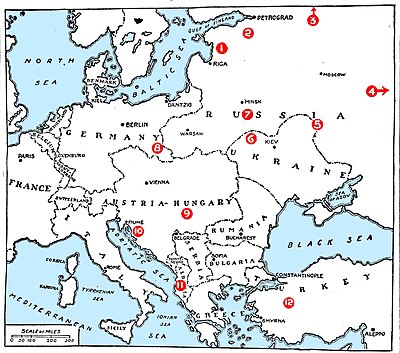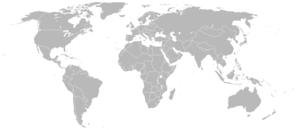
Back فترة ما بين الحربين العالميتين Arabic Periodu d'enteguerres AST Інтэрбелум BE Период между световните войни Bulgarian Període d'entreguerres Catalan Meziválečné období Czech Y cyfnod rhwng y rhyfeloedd CY Mellemkrigstiden Danish Zwischenkriegszeit German Μεσοπόλεμος Greek
This article is missing information about the Estado Novo of Portugal established in 1933. (January 2025) |

- Baltic States War of Independence and Russian Civil War
- White Army - Yudenich
- North Russia intervention
- White Army - Kolchak in Siberia
- White Army - Denikin
- Ukrainian War of Independence
- Polish–Soviet War
- Silesia tension between the Poles and Germans.
- Romanian occupation of Hungary
- Gabriele D'Annunzio seizes Fiume, creates the Italian Regency of Carnaro
- Fighting in Albania
- Turkish War of Independence

In the history of the 20th century, the interwar period (interbellum) lasted from 11 November 1918 to 1 September 1939 (20 years, 9 months, 21 days) – from the end of World War I (WWI) to the beginning of World War II (WWII). It was relatively short, yet featured many social, political, military, and economic changes throughout the world. Petroleum-based energy production and associated mechanisation led to the prosperous Roaring Twenties, a time of social and economic mobility for the middle class. Automobiles, electric lighting, radio, and more became common among populations in the first world. The era's indulgences were followed by the Great Depression, an unprecedented worldwide economic downturn that severely damaged many of the world's largest economies.
Politically, the era coincided with the rise of communism, starting in Russia with the October Revolution and Russian Civil War, at the end of WWI, and ended with the rise of fascism, particularly in Germany and Italy. China was in the midst of a half-century of instability and the Chinese Civil War between the Kuomintang the Chinese Communist Party and many warlords. The empires of Britain, France, and others faced challenges as imperialism was increasingly viewed negatively and independence movements emerged in many colonies; in Europe, after protracted low-level fighting most of Ireland became independent.
The Russian, Ottoman, Austro-Hungarian, and German Empires were dismantled, with the Ottoman territories and German colonies redistributed among the Allies, chiefly Britain and France. The western parts of the Russian Empire, Estonia, Finland, Latvia, Lithuania, and Poland became independent nations in their own right, and Bessarabia (now Moldova and parts of Ukraine) chose to reunify with Romania.
In Russia, the Bolsheviks managed to regain control of Belarus and Ukraine, Central Asia, and the Caucasus, forming the Soviet Union. In the Near East, Egypt and Iraq gained independence. During the Great Depression, countries in Latin America nationalised many foreign companies (most of which belonged to the United States) in a bid to strengthen their own economies. The territorial ambitions of the Soviets,[2] Japanese, Italians, and Germans led to the expansion of their domains.
Militarily, the period would see a markedly rapid advance in technology which, alongside lessons learned from WWI, would catalyse new strategic and tactical innovations.[3] While the period would largely see a continuation of the development of the technologies pioneered in WWI, debates emerged as to the most effective use of these advancements.[4] On land, discussions focused on how armoured, mechanised, and motorised forces should be employed, particularly in-relation to the traditional branches of the regular infantry, horse cavalry, and artillery.[5][6] In the air, the question of allocating air forces to strategic bombing versus dedicating such forces to frontline close air support was the primary contention, with some arguing that interceptor development was outpacing bombers, and others maintaining that "the bomber will always get through." In the naval sphere, the primary question was whether battleships would maintain their dominance of the seas or be rendered virtually obsolete by naval aviation.[7][8] The military deliberations and controversies characteristic of the interwar period would ultimately find resolution via the events of WWII,[9] which served as a foundation for many of the tenets, doctrines, and strategies of modern warfare.[10] Overall, the innovations of WWI and the interwar period would see a shift away from traditional line- and front-based warfare and towards a significantly more mobile, mechanised, and asymmetric form of combat.
- ^ Simonds, Frank H. (9 November 1919). "A Year After the Armistice—The Unsettled Disputes". New-York Tribune. p. 26. Archived from the original on 9 November 2019. Retrieved 10 November 2019.
- ^ "Invasion of Poland, September 1939". The National WWII Museum. 17 October 2023. Archived from the original on 11 May 2024. Retrieved 15 June 2024.
The result was the Molotov-Ribbentrop Pact of August 23 [1939]… the crucial part of the agreement… reshaped the map of Central Europe… Bessarabia, Finland, Estonia, Latvia, and eastern Poland would become part of Stalin's sphere of influence…
- ^ "Military aircraft - Interwar, Developments, Technology | Britannica". 24 June 2024.
- ^ "Interwar Airpower, Grand Strategy, and Military Innovation: Germany vs. Great Britain". 28 February 2018.
- ^ Murray, Williamson (1996). "Armored warfare: The British, French, and German experiences". Military Innovation in the Interwar Period. pp. 6–49. doi:10.1017/CBO9780511601019.002. ISBN 978-0-521-55241-7.
- ^ Carter, Daniel S. (June 2005). Innovation, Wargaming, and the Development of Armored Warfare (PDF) (M. Poli. Sci. thesis). Massachusetts Institute of Technology.
- ^ "Incubate Innovation: Aviation Lessons from the Interwar Period".
- ^ "Innovation for the Interwar Years".
- ^ "The Great Debate".
- ^ "How did WWI reshape the modern world?". 9 November 2018.